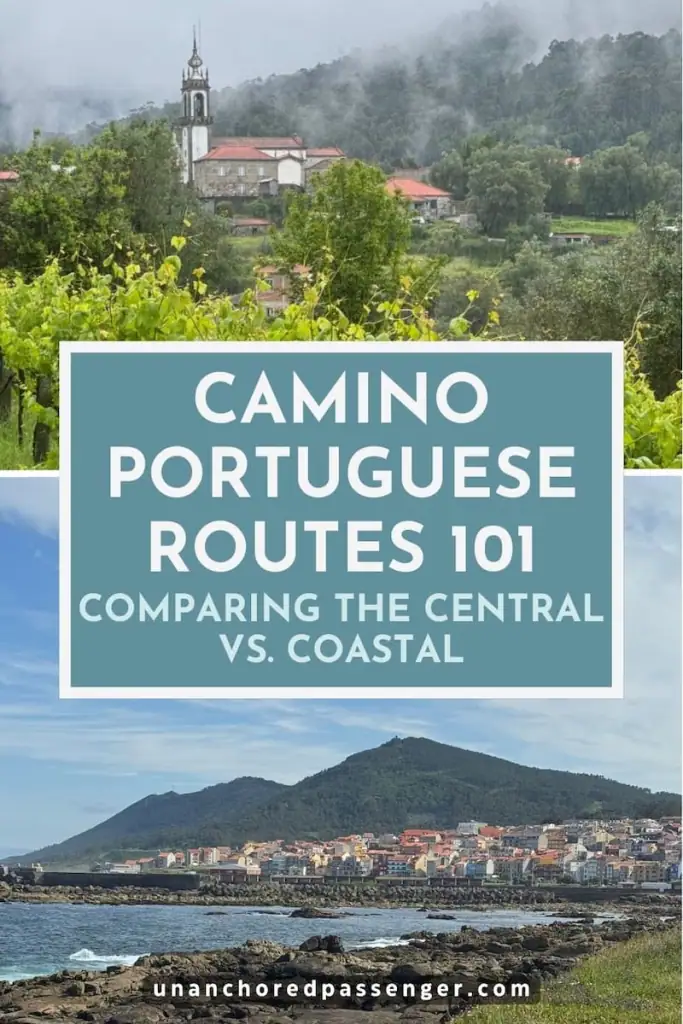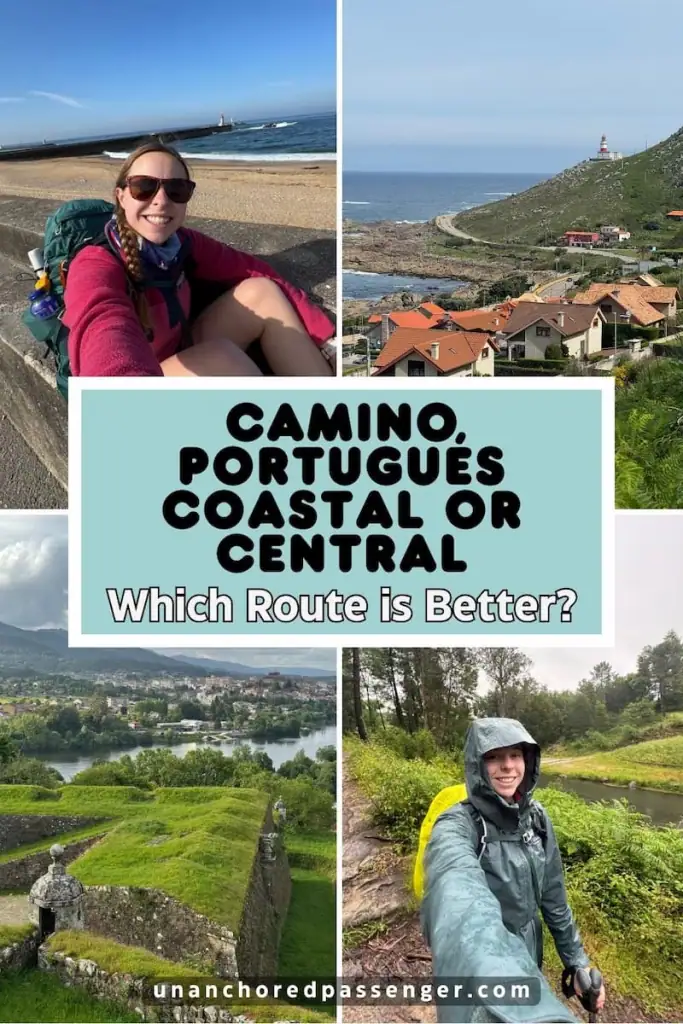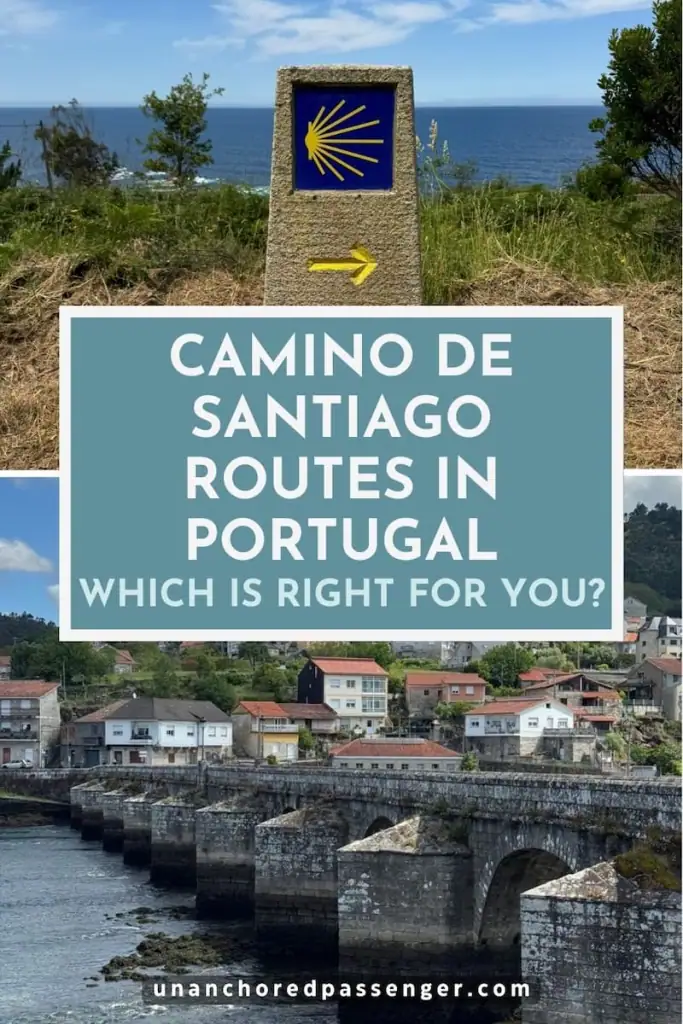Camino Portugués Coastal or Central: Which is Best for You?
Have you decided to hike the Camino Portugués but you're absolutely torn between the Coastal and Central routes?
I get it. I've been exactly in your shoes. It was part of the reason why I actually decided to hike both when I was last on the Camino solo, starting from Porto in May 2025.
I also wanted to see both of them for myself so I could give you all the latest information you need to decide if the Camino Portugués Coastal or Central route is right for you. Keep reading to learn more about how these two paths differ when it comes to difficulty, making friends, cost, and more.
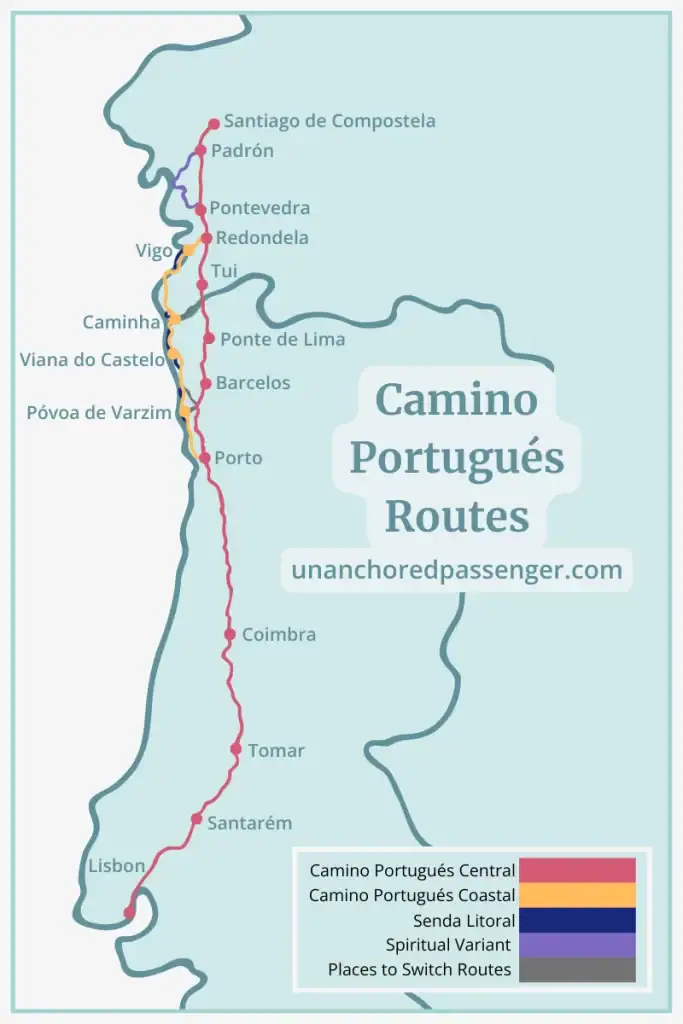
Camino Portugués Coastal vs. Central Map
There are two main Camino Portugués routes: the Coastal and the Central, which is what this article will focus on. However, as you think about your plans for the Portuguese Way, keep in mind that there are a few other paths to consider:
- Senda Litoral (Litoral Way): This route pops up fairly frequently along the Coastal route, giving you the option to more closely follow the coastline. It usually only lasts for a handful of kilometers before rejoining the Coastal route.
- Variante Espiritual (Spiritual Variant): This quiet route starts just north of Pontevedra, meaning you can take it no matter if you choose the Camino Portugués Central or Coastal route. Along the Spiritual Variant, you get to take a boat that follows the same path that legend says the boat carrying the remains of Saint James took into Galicia.
- Switching Between Routes: You don't have to necessarily choose only the Central or only the Coastal! As you can see in the map, there are a few points where you can switch between routes.
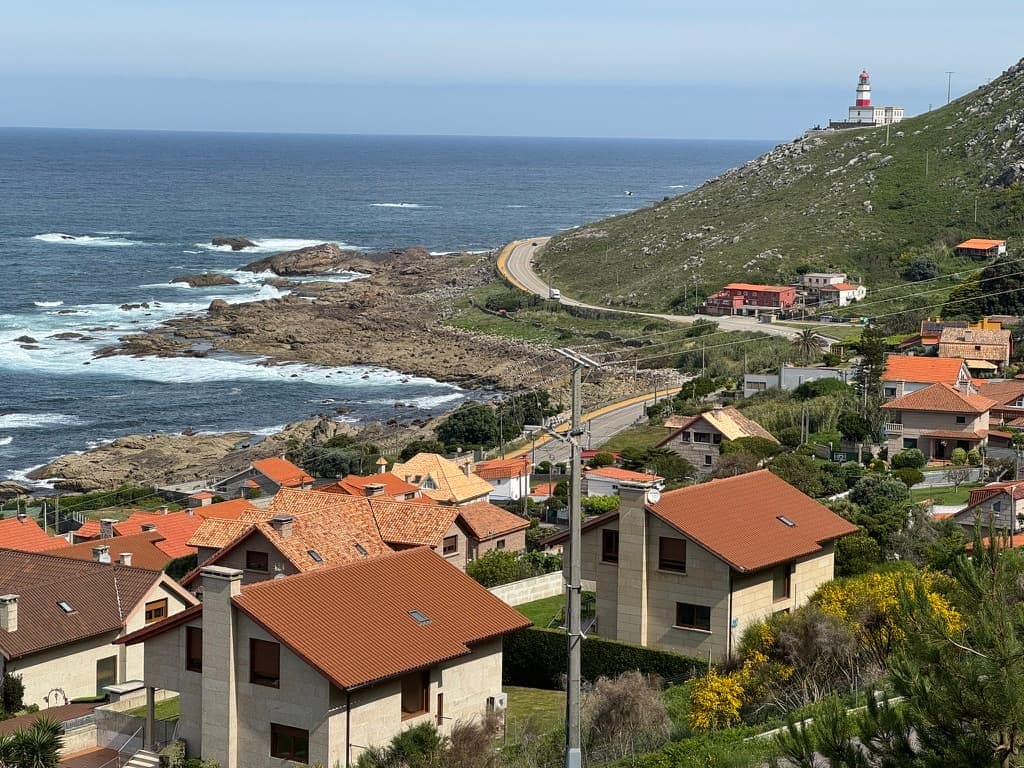
At a Glance: Quick Comparison of the Two Main Portuguese Camino Routes
At a high-level, here are the key differences I noticed between these two Caminos:
- The Coastal route is slightly longer and flatter than the Central route.
- The Coastal route offers views of the ocean and is more developed with larger cities and towns whereas the Central route is more inland and tends to pass through quieter villages.
- The Coastal route felt slightly more social to me, but at the same time you're more likely to lose some friends on this route when they switch over to the Central.
- The Coastal route is the fastest growing Camino route in terms of popularity and the trail felt busier to me than the Central route (aside from the last 100 km).
- Churches on the Central route seem to be rarely open on the Portuguese side whereas the Coastal route offers more opportunities to visit churches.
Full Comparison of the Camino Portugués Central and Coastal Routes
I firmly believe every Camino route has something to offer, and every pilgrim is unique in their needs and desires for their Camino. Here I'll dive into various factors for you to consider when comparing these two routes so you can be better equipped to decide based on what's most important to you.
And–spoiler alert–if you really can't decide between the Camino Portugués Central and Camino Portugués Coastal after this, then you absolutely can mix and match them! I'll get into that more below.
Length
The Coastal Camino Portugués route is slightly longer than the Central route. Most pilgrims start one of the routes from Porto–from there the distance is as follows:
- Central route: 151 miles (243 km) (typically takes about 10-14 days)
- Coastal route: 170 miles (274 km) (typically takes about 12-15 days)
Technically the Central route starts in Lisbon, but it's not as popular because the infrastructure between Lisbon and Porto isn't as good. Here are the distances from Lisbon:
- Central route: 384 miles (618 km) (typically takes about 25-30 days)
- Central route, then switching to the Coastal in Porto: 403 miles (648 km) (typically takes about 27-31 days)
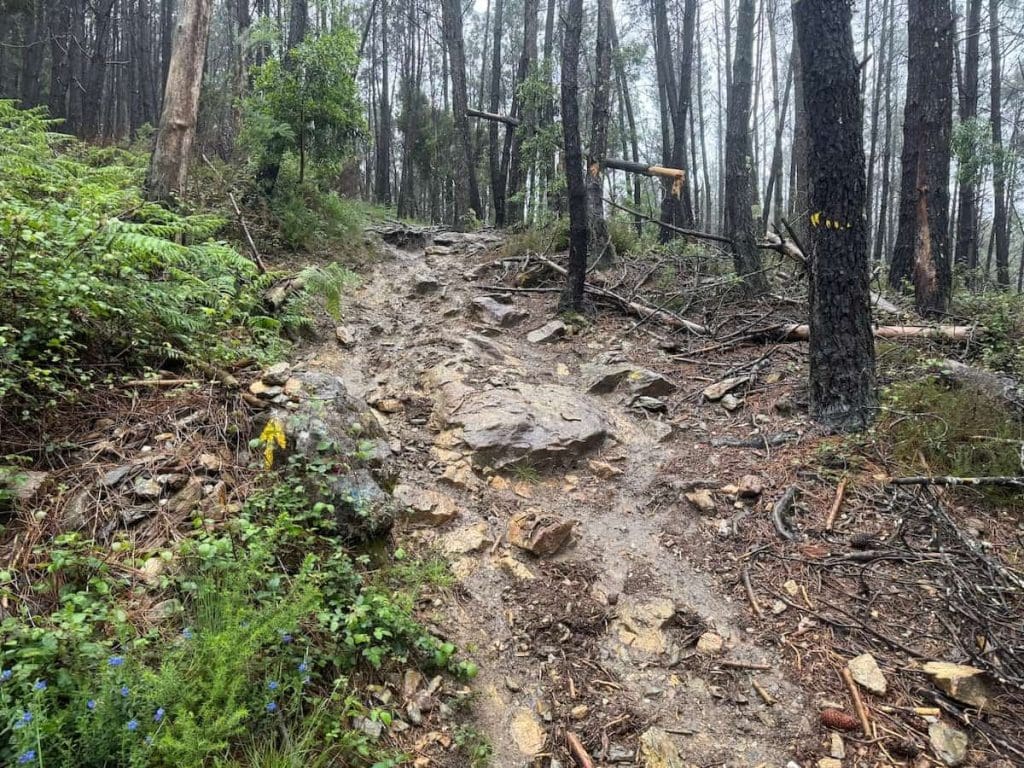
Difficulty
Both Camino Portugués routes are considered some of the easier Camino routes due to little elevation gain. The Coastal is slightly flatter but not by much.
According to AllTrails, here's the total elevation gain for each route:
- Camino Portugués Central from Porto: 17,106 ft (5,214 m)
- Camino Portugués Coastal from Porto: 17,007 ft (5,184 m)
The trail surface can be a little challenging on both of these routes for some people though. Portugal is known for its cobblestones, which can be quite uneven and uncomfortable to walk on after a while.
The Central route mostly just has cobblestones, roads, and some dirt/gravel paths. The Coastal, however, also has boardwalks.
I personally liked having the boardwalks because it meant less cobblestone walking. That said, some folks find the boardwalks challenging.
I didn't find the boardwalks as bad as some folks in Facebook groups would have led me to believe, but there were a couple times I encountered boardwalks that didn't seem well constructed. Some had large gaps between planks or uneven planks that made for a tripping hazard.
Scenery
Scenery is arguably the biggest difference between these two routes.
Are you looking for a quieter walk with smaller villages and more rural scenery? Choose the Central.
Or would you prefer ocean views and bigger towns and cities along the way? Choose the Coastal.
Some people say they feel the scenery along the Coastal route is monotonous, but I didn't find that to be true at all. The first two days are pretty similar, but after that, there's a lot of variation with walking through forests, small villages, and even up some hills with good lookout points.
The scenery along the Central route includes more rural farms, vineyards, forests, and small villages. There are a few places with some elevation gain and areas where you feel like you're on more of a proper hiking trail.
I really enjoyed the scenery on both routes, but I was so in awe of the views along the water on the Coastal route. The water is such a striking blue green color and the waves are incredibly strong and powerful. I'm not used to ocean views like that where I live, so it was really special for me.

Infrastructure
The infrastructure along both routes is pretty good, but I'd say it's slightly better on the Central route, likely since that route has been popular for longer.
Accommodation options seemed somewhat similar on both routes, but in my experience, there were more long stretches without places to stop for food on the Coastal route.
For instance, the day I hiked from Viana do Castelo to Caminha, I didn't see anywhere to stop for breakfast on the way until about 6 miles (9.6 km) into the hike.
Note that the infrastructure differs drastically on the stretch of the Central route between Lisbon and Porto. From what I've heard, there are far fewer accommodation options and places to get food along the way.
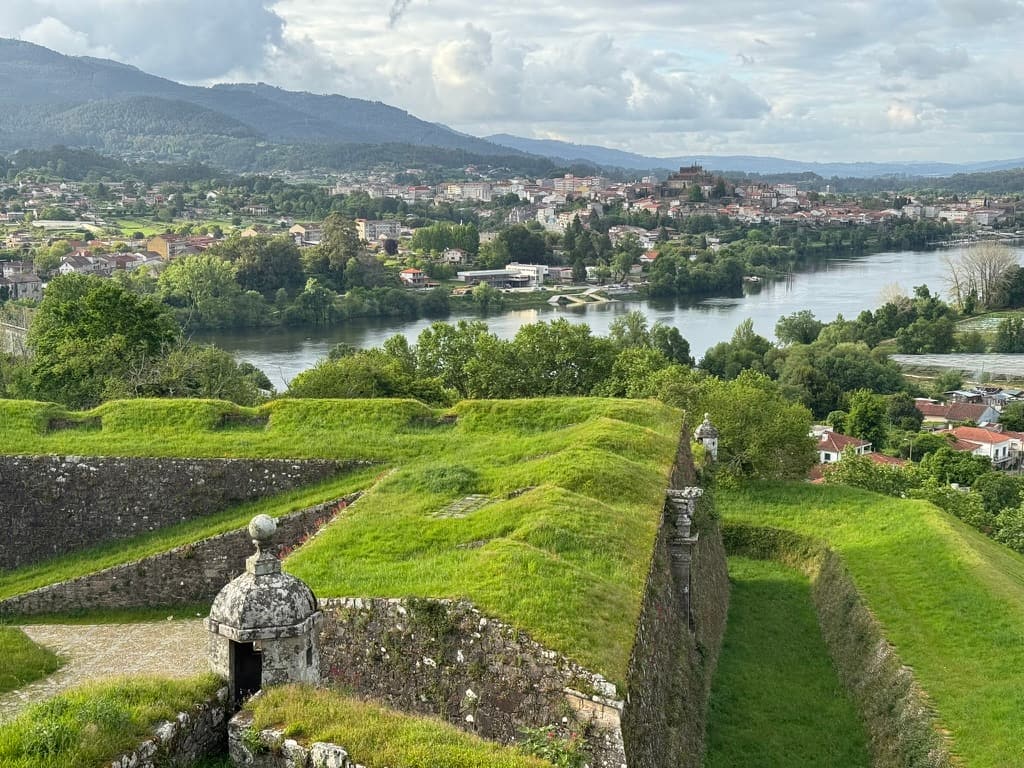
Notable Cities on Each Route
I always love that the Camino takes you through some very cool places that you may not otherwise visit. Each route on the Portuguese Way includes stops in some notable cities that you'll be glad you visited.
On the Central route from Porto, here are some of the most notable stops:
- Barcelos, Portugal, a charming city home to a legend that explains Portugal's rooster symbol
- Ponte de Lima, Portugal, considered the country's oldest town
- Valença, Portugal, home to a medieval fortress that encloses its old town–this was one of my favorite stops between both of these Caminos
- Tui, Spain, a town right across the river from Valença with its own medieval center
Here are some of the most notable stops along the Coastal route:
- Viana do Castelo, Portugal, a lovely seaside city with a church on top of a large hill–I so wish I'd had more time and energy to visit because the views are supposed to be spectacular
- Caminha, Portugal, a small historic town with ocean views and from here, you take a boat to cross into Spain
- Baiona, Spain, home to a fortress that juts out into the ocean and even has a Parador hotel that you can stay in–this was one of my favorite stops between both of these Caminos
- Vigo, Spain, the country's 15th largest city, an important fishing and industrial center in the region, and home to stunning natural landscapes, like the nearby Cíes Islands

No matter which route you choose, you'll also get to visit iconic cities like:
- Porto, Portugal, the second largest city in the country and a UNESCO World Heritage Site with so much to do
- Pontevedra, Spain, a city with the second most important historical center in Galicia after Santiago de Compostela
- Padrón, Spain, home to the delicious Padrón peppers dish common throughout Galicia
- Santiago de Compostela, Spain (of course!) where you can visit the spectacular cathedral and even stay at a hotel that used to be a pilgrim hospital centuries ago

Route Choices
The cool thing about the Camino Portugués from Porto is you have a lot of flexibility in the exact route you take. You can switch from the Coastal route to the Central and vice versa.
That said, the Coastal route offers a bit more choices when it comes to your route. It's generally easier to switch from the Coastal route to the Central route. Plus, the Coastal route also has the Litoral Way, also known as the Senda Litoral, which allows you to walk closely along the coastline in a number of places.
This Senda Litoral pops up quite often during the Coastal route, branching off and rejoining it frequently. It's never so long though that you have to change your plans around it–you can more so decide on the day if you want to take that route or stay on the Coastal.

Ability to Make Friends
Both Camino Portugués routes are fairly social and offer the opportunity to make friends.
Don't be fooled if you read that the Camino Portugués Coastal is a solitary route–it used to be, but as the fastest growing Camino route last year, it's not anymore. I personally saw more people on the Coastal Portuguese route during the day and in my accommodations. However, some of them switched to the Central route, which meant I didn't see them again.
The Central route was quieter for me, and I didn't see very many people hiking each day until I reached the last 100 km. I was able to meet people in my accommodations though. On the plus side, it seemed like people who started on the Central route stayed on it, which meant that I continued to see some of the same people throughout my whole Camino.
For instance, I met one gal from Germany on my first day and we kept seeing each other the rest of the way and eventually walked into Santiago de Compostela together.
Connect with Other Women Hiking the Camino
Join my free Facebook group! We're building up a community of women who have hiked or are planning to hike the Camino there. You can also get personalized support from me!
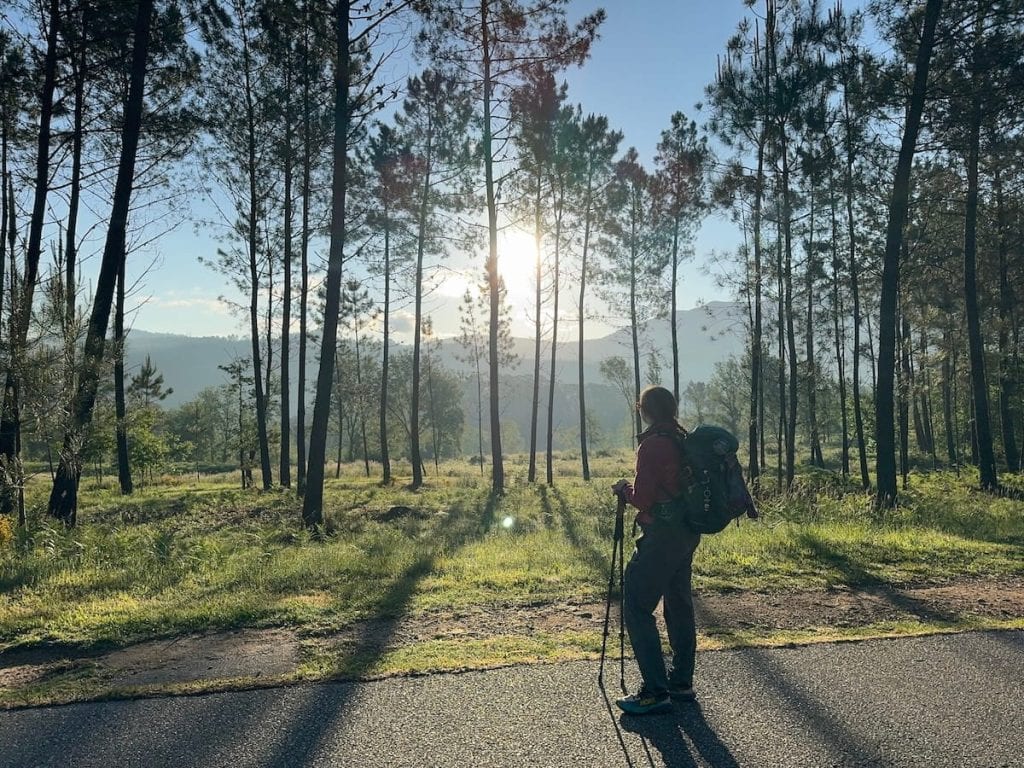
Crowds
Last year 95,453 pilgrims completed the Central route and 74,758 completed the Coastal route. That said, a large portion of the pilgrims who did the Central route started in Tui as it's the last stop on the Central route you can stay if you want to reach the minimum 100 km distance needed for a certificate.
Like any route, the last 100 km of the Camino Portugués gets quite crowded, no matter if you're starting in Vigo on the Coastal route or Tui on the Central route. Before then though, these routes are much quieter. Last year 27,301 pilgrims who did the Central route and 22,414 who did the Coastal route started in Porto.
In my experience in 2025 from Porto, the Camino Portugués Central route seemed to be less crowded than the Coastal, at least until you reach the last 100 km. Especially the first few days out of Porto on the Central route, I found myself wondering, Where the heck is everybody?
On both routes, I had time to myself where I didn't see anyone around me, but it was much more common on the Central. On the Coastal, I found I often saw more people around.

If you want to avoid crowds while walking the last 100 km to Santiago, it's easy to do so for much of the way if you take the Spiritual Variant. This is an alternate route to Santiago that starts just outside of Pontevedra and rejoins the Central route near Padrón.
Alternatively, you can also avoid crowds by staying “off stage,” avoiding stopping in towns recommended by guidebooks.
During my first hike, I mostly stayed on stage on the Central route and found myself frustrated a few times by the crowds in the last 100 km. There were times when I counted groups of 30+ or more people on the trail. I'd say “Buen Camino” to some of the people and they'd completely ignore me and look at me like I was weird for talking to them.
There was even a couple in front of me that kept squeezing and touching each others butts right in front of me…
That wasn't the Camino spirit I was looking for, and I wished I had stayed off stage more for that last stretch. When I went back again, I did the Spiritual Variant and was much happier with how quiet and tranquil it was and with the friendly people I met along the way.
Safety
Both Camino Portugués routes are generally considered quite safe, even for women walking alone. The biggest risk for anyone is usually petty theft.
That's not to say incidents don't occur. Unfortunately, while it's not super common, I have read reports of creepy men following women on both of these Camino routes. I imagine incidents like this will decrease as both routes continue to grow in popularity.
I hiked both routes solo and felt safe. I'd say I felt slightly safer on the Coastal route because more people were around, but I was never too far from other pilgrims on the Central route either.
When it comes to road safety, both routes do have stretches of road walking where you'll want to be careful as well. I didn't feel that one was particularly worse than the other when it came to this though.
Know that I've heard the stretch between Lisbon and Porto has some significant stretches of road walking. I met a couple ladies who walked from Lisbon and decided to take the bus for some portions because even the locals told them it would be better to take the bus than to walk.
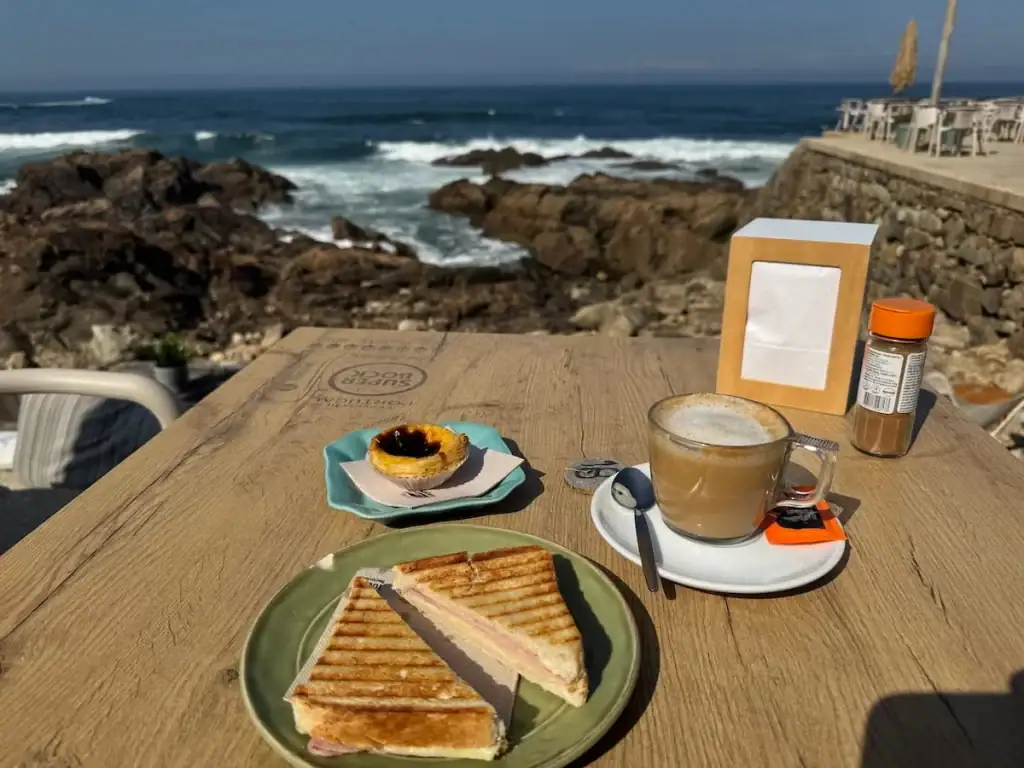
Cost
I found costs between the two routes to be fairly similar. The Coastal route can be slightly more expensive at times since you're passing through more developed and popular tourist areas.
There was one day where I was charged about double for my breakfast just because of the ocean view from the terrace. For the most part though, I didn't find many restaurants charged that much more.
And when it comes to accommodations, albergue prices were similar across both routes. However, I imagine private rooms may be pricier on the Coastal route particularly during busy tourist seasons.

Weather
While both Portuguese Way routes are quite close to each other, they can experience some differences in weather. The Camino Portugués Central tends to be a bit hotter while the Coastal has milder temperatures. The Coastal route can have strong winds at times too.
I feel like I experienced the opposite though, so you want to be prepared for anything. When I hiked the Central route, weather was cooler and there was more rain. Then when I hiked the Coastal route, it was super cold from strong winds for a few days but was otherwise hot, sunny, and it didn't rain a single day.
History
The Camino Portugués Central has historically been the more popular path. It follows old Roman roads for much of the way. Medieval pilgrims are known to have taken this route, including a German doctor in 1494 and an Italian priest in 1594.
While the Camino Portugués Coastal route is considered newer, it has its history too.
Of note, the oldest inscription dedicated to Saint James outside of Spain, dated 862, can be found in a church in Castelo do Neiva on the Coastal route. Viana do Castelo is home to an old pilgrim hospital that had opened in 1468. In addition, in 1502 Portugal's King Manuel I visited Azurara and Vila do Conde on his pilgrimage, and there you can see the churches he ordered to be built.

Religion
While the Camino Portugués Central route is considered the more “traditional” of the two, I was surprised to find fewer options to visit churches and attend pilgrim's masses along the way. There were plenty of churches along the route, but they were almost always closed on the Portuguese side.
In contrast, it seemed most churches along the Camino Portugués Coastal were open and there were more opportunities to attend pilgrim's mass.
If visiting churches is important to you, then I recommend you hike the Coastal route.

Tips to Choose Between the Camino Portugués Coastal or Central Route
Are you still struggling to figure out if the Camino Portugués Coastal or Central is best for you? Here are some tips to keep in mind that may help. In addition, check out this post for more advice on picking your route.
- Think about why you decided to walk the Camino and what you really want to get out of the experience. If you're a numbers person like me, you may want to give a rating to each criteria that's important to you and use that to help you decide your route. You can use the spreadsheet linked below to help you with that.
- Think about how much time you have. If you're short on time, you may prefer to hike the Central route since it's slightly shorter. That said, know that you can start anywhere along either route that fits your schedule.
- Consider hiking both! Many pilgrims opt to do a mix of routes (more on that below). Or you could hike one first and plan to return another time to hike the other.
Combining Both Routes
You don't have to just choose one Camino Portugués route. In fact, many people choose to hike a mix of both!
The most popular options involve starting on the Coastal route and then switching to the Central by walking from:
- Vila do Conde to São Pedro de Rates
- Caminha to Valença
You can switch from the Central to the Coastal route, but it usually involves backtracking a little bit, which is one reason why it's more common to start on the Coastal first. The views leaving Porto are also much better on the Coastal route than on the Central.
My Favorite Camino Portugués Route
If I had to choose just one of these routes, I'd pick the Coastal. I was pleasantly surprised by how social the route was, and I was absolutely in awe of the scenery along the water.
If I'm being honest, as much as I loved the Central route, I was slightly disappointed by it. I think I expected it to be more similar to the Camino Francés.
Don't let my experience dissuade you though. I still loved my time on the Central–it was my own fault for expecting it to be so similar to the French Way.
Both routes are spectacular and have much to offer. Either could be great for you, whether it's your first, second, or third Camino.

Frequently Asked Questions
Here are some answers to frequently asked questions when it comes to deciding between the Camino Portugués Coastal or Central route.
Which Portuguese Camino route is best?
The best Portuguese Camino route depends on what you're looking for. If you want coastal views, the Coastal route is better for you. If you want more tranquil countryside villages, then the Central route is better for you.
What is the difference between Camino Portuguese coastal and inland?
Aside from ocean views, the Coastal route is also more built up with larger towns and cities along the way. The inland route, called the Central route, passes through more rural areas and quieter villages.
Which Portuguese coastal Camino has a Spiritual Variant?
No matter whether you choose the Coastal or Central route, you can do the Spiritual Variant. The Spiritual Variant starts just north of Pontevedra, after the Coastal route joins the Central route.
What is the difference between Camino Portuguese Litoral and Coastal?
The Litoral Way, or Senda Litoral, is a path that often branches off of the Camino Portugués Coastal route to more closely hug the ocean. It's not its own fully independent route as it joins with the Coastal route quite often.
Is the Portuguese Camino safe?
The Portuguese Camino is generally safe with the most common crime being petty theft. I've unfortunately read about incidences of women being followed by creepy men, but those incidents seem to be rare and are probably unlikely to happen if you're hiking during a busier time of year.

Conclusion: Choosing Your Camino Route
As you can see, there's a lot to consider when deciding between the Camino Portugués Coastal or Central route. I ultimately think it comes down to whether you'd prefer the ocean views along the Coastal route or the more tranquil quiet villages along the Central route.
Spend some time thinking about it and consider what's most important to you. If you're really torn between the two, then I think that means you need to do a mix of both!
Dive Deeper Into the Camino Portugués Routes
You may find it helpful to review each route in more detail to help you decide. Check out these articles on the stages for the Coastal route and stages for the Central route.
